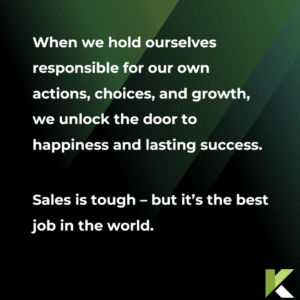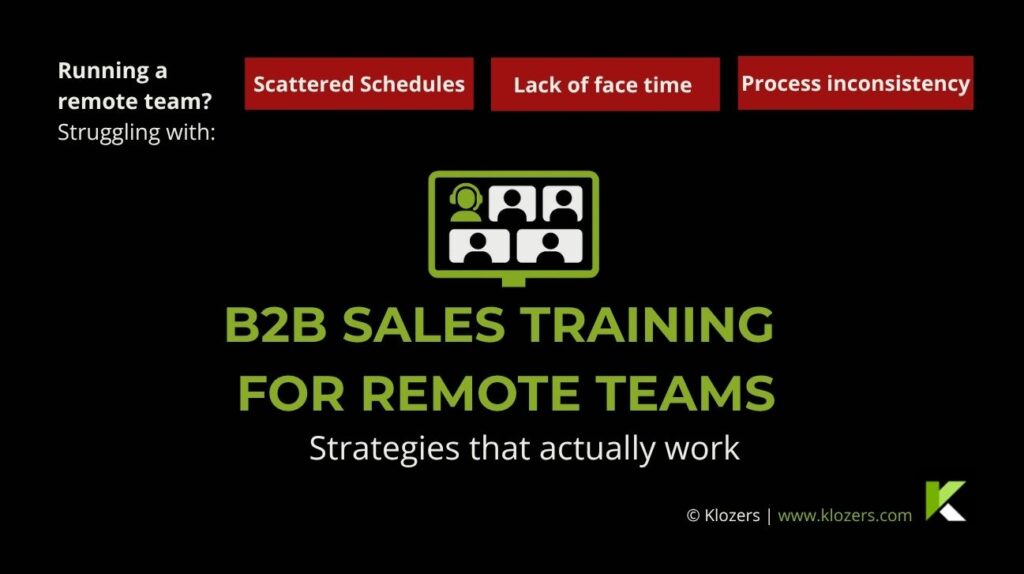B2b Sales training for remote teams - Top Question FRom Google
What is B2B Sales Training?
B2B sales training is a system that teaches your sales representatives how to sell to other businesses. It addresses the whole gamut of prospecting, pipeline maintenance, negotiation, and closing skills, but adapted to the longer and more complex sales cycles.
Free access to our best tools and templates
Introduction to B2B Sales Training for Remote Teams - Strategies that Actually Work
Training a sales team is always a challenge, and the complexity increases significantly when that team is working remotely. Remote training presents a unique set of challenges, including coordinating across time zones, managing connectivity issues, and navigating virtual role-plays.
Despite these challenges, remote work is clearly here to stay. According to a 2024 HubSpot report, over 60% of B2B sales professionals now work either fully remotely or in hybrid roles, a trend that shows no signs of slowing.
The encouraging news is that, with the right structure, remote sales training can be just as effective, and in some cases even more effective than traditional in-person sessions. The key lies in rethinking delivery methods and adapting to the realities of distributed teams.
This guide outlines actionable strategies that help remote B2B sales teams learn, stay connected, and, most importantly, perform at their best.

The Unique Challenges of Training Remote Sales Teams
Training your remote sales teams comes with a host of challenges. Here are some of the most difficult ones that you just can’t ignore:
Scattered schedules and time zones
Not everyone is online at the same time, and trying to find a training slot that works for everyone on your team can feel impossible. Flexibility becomes essential in this situation.
Lack of Face Time
You can’t rely on hallway chats or quick desk visits to course-correct someone or clarify something they missed. Everything needs to be more intentional when you are dealing with a remote team.
MOTIVATION CAN DIP
Without the buzz of an office, your remote reps can feel isolated. It’s easy to fall into a rut if there’s no energy or momentum. This can be an even bigger challenge if your team is spread across time zones.
PROCESS INCONSISTENCY
If your reps are remote and training isn’t structured, you’ll end up with everyone doing their own thing, which usually means misalignment and dropped deals. The absolute last thing your bottom line needs.
Ultimately, B2B sales training for remote teams requires more than video conferencing and shared documents. It demands a deliberate approach, one that blends structure, interaction, and a strong sense of human connection.
The Core Ingredients of Great Remote Sales Training
Effective remote B2B sales training is designed with impact in mind. Below are the core components that ensure your program prepares sales reps for the challenges of selling in a virtual-first world:
Structure
Clearly outlined schedules help reduce uncertainty and improve attendance. Combining live sessions, self-paced modules, and periodic check-ins provides both consistency and flexibility. However, over-scheduling can reduce effectiveness, so it’s important to strike a balance that keeps engagement high.
Interactive approach
Passive learning rarely delivers results. Incorporating breakout discussions, live Q&A sessions, polls, and virtual roleplays helps reinforce material and keeps learners engaged. Interaction encourages the practical application of skills rather than mere knowledge retention.
The Right Tools
Organizations do not need expensive training platforms to succeed. Many effective programs begin with tools already in use:
- Zoom or Teams for real-time training
- Loom or Vidyard for asynchronous coaching
- Notion or Google Docs for playbooks
- CRM systems for deal reviews
- Slack channels for team engagement and knowledge sharing
The goal is to enable learning and collaboration using accessible, familiar platforms.
Reinforcement
Retention requires repetition. Regular knowledge checks, quizzes, and review sessions help remote learners internalize information over time. Microlearning, short, focused learning sessions, can be particularly effective in this environment.
Tracking progress
In remote settings, informal progress checks are not always possible. Weekly one-on-one meetings offer a structured way to review pipelines, provide feedback, and reinforce key skills. Managers should use these touchpoints to maintain accountability and guide development.
At Klozers, we’ve seen how adopting a process-first mindset helps remote teams stay aligned, motivated, and consistent, even when spread across continents.

5 Steps to Deliver Effective Remote B2B Sales Training
Training effectiveness is driven by thoughtful design and consistent execution. Here are five practical steps to help build or improve your remote sales training program:
1. Audit Existing Processes
Clearly outlined schedules help reduce uncertainty and improve attendance. Combining live sessions, self-paced modules, and periodic check-ins provides both consistency and flexibility. However, over-scheduling can reduce effectiveness, so it’s important to strike a balance that keeps engagement high.
2. Set a Clear Training Rhythm
Establish a cadence that blends structure and flexibility:
- Weekly live training sessions or drills
- On-demand learning through video content or an LMS
- Peer learning via group discussions or breakout sessions
- Scheduled office hours for open Q&A
Consistency builds habits. When reps know what to expect, they’re more likely to participate fully.
3. Blend Coaching Formats
Variety enhances engagement. Combine:
- Manager-led feedback sessions
- Peer-to-peer coaching
- Self-assessment through recorded call reviews
- Strategic debriefs based on actual deals
This multifaceted approach helps avoid fatigue and promotes deeper learning.
4. Integrate Metrics into the Conversation
In addition to tracking activity levels, monitor performance indicators such as:
- Time to first deal
- Call-to-meeting conversion rates
- Self-reported confidence levels (via surveys)
- Adherence to the sales process
When reps understand what success looks like and where they stand, improvement becomes more tangible.
5. Iterate Based on Feedback
Effective training programs evolve over time. Use short surveys, one-on-one meetings, or informal discussions to gather feedback. Adjust formats, timing, or content delivery based on what the team finds most helpful.
Organizations working with partners like Klozers often rely on practical frameworks, lightweight checklists, and CRM integrations to streamline training, without adding unnecessary complexity.
What Actually Works in Real-World Remote Sales Training?
Remote training success depends on human-centered strategies that support learning and connection. Here are a few proven approaches that work well with distributed sales teams:
Create a virtual buddy system
Pair new hires with experienced team members for informal coaching, guidance, and peer support. These check-ins, even once a week, provide a valuable sense of connection and continuity.
Share real-world call recordings
Capture and share recordings from high-performing reps (with consent) to demonstrate effective techniques. Annotated examples can be compiled into a library for continuous reference and learning.
Prioritize human interaction
Begin sessions with short personal check-ins. Celebrate milestones. Use humor and positive reinforcement. A human-first approach prevents virtual training from feeling impersonal or overly scripted.
Blend live and on-demand formats
Foundational concepts can be delivered asynchronously, while live sessions are best used for practice and discussion. This hybrid model offers flexibility while maintaining group cohesion.
Use visuals and plan breaks
Breaking sessions into shorter segments (15–20 minutes) and incorporating visuals such as diagrams or virtual whiteboards increases engagement. Scheduled breaks also help combat virtual fatigue.
Introduce gamification
Gamified learning adds motivation and a sense of achievement. Offer small rewards for completed modules or successful application of new skills. Even simple scoreboards or team-based challenges can enhance participation.
Train smarter, not harder
Remote work isn’t going anywhere, and neither are the challenges that come with it. But with the right approach, your B2B sales training can still be personal, impactful, and process-driven.
Start small and build a rhythm, and don’t forget to keep things interactive. And most importantly, listen to your reps. The best training programs evolve with your team.
There’s plenty of support out there to help, whether it’s tools, playbooks, or coaching systems. A lot of successful teams (including many who work with Klozers) are using these strategies to build high-performing, remote-ready sales forces.
So give it a go, experiment, and iterate. Remember that training is a conversation, and one your reps should want to be part of.
ACTIONABLE TIP
Build a Training Rhythm That Blends Structure with Flexibility
One of the biggest mistakes in remote sales training is overloading reps with content or relying too heavily on one format (e.g. endless Zoom calls). Instead, create a consistent training rhythm that balances predictability with adaptability, so your team knows what to expect, but still has room to learn on their own terms.
Start by setting a weekly cadence:
One live session per week (30–60 mins) focused on a single core skill like objection handling, qualification, or negotiation.
Supplement that with on-demand video content, broken into 5–10 minute segments, that reps can revisit as needed.
Use asynchronous tools like Loom to record mini-coaching moments or provide feedback on call reviews, especially helpful for reps in different time zones.
Carve out “open office hours” each week for informal Q&A or group coaching drop-ins. It keeps the door open without crowding calendars.
This approach does three things: it builds accountability, makes learning habitual, and respects that not all reps learn the same way. With consistency and variety, you’re not just running training: you’re building a culture of continuous development that works, even remotely.




